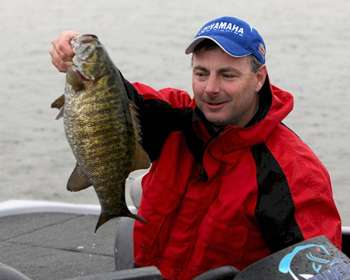
Each spring, as bass anglers head to the water, ready to dust the cobwebs away from a winter-long hiatus, they're faced with a conundrum — suspending jerkbait or floating jerkbait? Elite Series pro Mark Menendez reveals that for him, the decision is quite simple.
"Water temperature dictates this decision every single time," he says. "In cold, clear water I want to use a suspending jerkbait. In warmer water, I'll use a floating jerkbait." While this may seem like an easy decision, there's more to the story.
In cold-water situations, particularly during the prespawn, Menendez reveals that you want the bait to be perfectly neutral in the water column. "Every bait you pick up, even in the same brand and model, will be just a little different," he says. "For that reason, I test each one before I use it."
By filling his kitchen sink with cold tap water, Menendez creates a jerkbait test laboratory where jerkbaits that are not neutrally buoyant get some emergency surgery. "There's always room for human error in the manufacturing process so you have to try multiple baits to make sure they're completely neutral in buoyancy," he explains.
"If a bait doesn't suspend properly, I'll add weight to the bait until it does. I'll either add a little lead around the hooks until it suspends or I'll put some Suspend Strips on the bait's belly." The Kentucky pro points out that he doesn't put a lot of "science" behind his testing process, admitting that testing baits in a sink full of cold tap water doesn't truly replicate a real-world scenario. But he suggests that it's better to err on the side of being a little too light than too heavy. "The colder the water, the denser it becomes, so usually cold tap water is going to be a pretty good match," he explains.
"You never want to keep adding weight until the bait slowly sinks, as I believe that detracts from the appeal of a suspending jerkbait. The magnetism is created during the pause, when a bait should suspend in place, or maybe begin to rise ever so slowly."
To truly test the bait's fish-attracting capabilities, it should be rigged exactly how it will be used. "If you change the hooks on your bait before you fish it, you need to do so before you test it," he explains. "As a final step, once everything has been tested, I Super Glue the Suspend Strips on the bait so that they don't come off." So when does the suspending jerkbait lose its luster? Menendez believes that's somewhere around 55 degrees in water temperature. "That's when you want to switch over to the floater, which I primarily use as more of a search bait," he reveals. "I move it a lot harder and faster. And depending on the species of bass I'm fishing for, I might fish it on fluorocarbon line rather than monofilament."
Line selection is particularly important when fishing a floating jerkbait for smallmouth. "You don't want to have any stretch in your line with those rascals," he comments. "As soon as one hits the bait, I want its head turning toward my boat.
That's why I like fluorocarbon — because it has less stretch." Conversely, if Menendez is fishing a floating jerkbait for largemouth, he opts for monofilament. "When I'm fishing in Northern waters, I try to create a flash every time that bait rolls on its side to trigger a strike," he explains. "When I'm fishing for largemouth with a jerkbait down South, I want the presentation to be a little more subtle. For that reason, I go with monofilament."
(Provided by Z3 Media)




